Electrocatalytic Properties of Quasi-2D Oxides LaSrMn0.5M0.5O4 (M = Co, Ni, Cu, and Zn) for Hydrogen and Oxygen Evolution Reactions
Abstract
:1. Introduction
2. Results and Discussion
2.1. Crystal Structure
2.2. Oxidation State and Oxygen Content
2.3. Electrical Conductivity
2.4. Hydrogen Evolution Reaction
- Volmer reaction (acidic): H3O+ + M + e− ⇌ M − H * + H2O
- Volmer reaction (alkaline): H2O + M + e− ⇌ M − H * + OH
- Heyrovsky reaction (acidic): M − H * + H3O+ + e− ⇌ M + H2 + H2O
- Heyrovsky reaction (alkaline): M − H * + H2O + e− ⇌ M + H2 + OH−
- Tafel reaction (acidic and alkaline): 2M − H * ⇌ 2M + H2
2.5. Oxygen Evolution Reaction
3. Experimental Methods
4. Conclusions
Supplementary Materials
Author Contributions
Funding
Data Availability Statement
Conflicts of Interest
References
- Lee, J.G.; Hwang, J.; Hwang, H.J.; Jeon, O.S.; Jang, J.; Kwon, O.; Lee, Y.; Han, B.; Shul, Y.-G. A new family of perovskite catalysts for oxygen-evolution reaction in alkaline media: BaNiO3 and BaNi0. 83O2. 5. J. Am. Chem. Soc. 2016, 138, 3541–3547. [Google Scholar] [CrossRef] [PubMed]
- Zhu, J.; Hu, L.; Zhao, P.; Lee, L.Y.S.; Wong, K.-Y. Recent advances in electrocatalytic hydrogen evolution using nanoparticles. Chem. Rev. 2019, 120, 851–918. [Google Scholar] [CrossRef] [PubMed]
- Lee, Y.; Suntivich, J.; May, K.J.; Perry, E.E.; Shao-Horn, Y. Synthesis and activities of rutile IrO2 and RuO2 nanoparticles for oxygen evolution in acid and alkaline solutions. J. Phys. Chem. Lett. 2012, 3, 399–404. [Google Scholar] [CrossRef] [PubMed]
- Tian, J.; Wu, W.; Tang, Z.; Wu, Y.; Burns, R.; Tichnell, B.; Liu, Z.; Chen, S. Oxygen reduction reaction and hydrogen evolution reaction catalyzed by Pd–Ru nanoparticles encapsulated in porous carbon nanosheets. Catalysts 2018, 8, 329. [Google Scholar] [CrossRef]
- Suntivich, J.; May, K.J.; Gasteiger, H.A.; Goodenough, J.B.; Shao-Horn, Y. A perovskite oxide optimized for oxygen evolution catalysis from molecular orbital principles. Science 2011, 334, 1383–1385. [Google Scholar] [CrossRef] [PubMed]
- Wickramaratne, K.M.; Ramezanipour, F. Impact of oxygen-vacancies on electrical conductivity and electrocatalytic activity of La3-xCaxFe2GaO9-δ (x= 0, 2; δ= 0, 1). Solid State Sci. 2023, 141, 107208. [Google Scholar] [CrossRef]
- Karki, S.B.; Hona, R.K.; Yu, M.; Ramezanipour, F. Enhancement of Electrocatalytic Activity as a Function of Structural Order in Perovskite Oxides. ACS Catal. 2022, 12, 10333–10337. [Google Scholar] [CrossRef]
- Hona, R.K.; Karki, S.B.; Cao, T.; Mishra, R.; Sterbinsky, G.E.; Ramezanipour, F. Sustainable oxide electrocatalyst for hydrogen-and oxygen-evolution reactions. ACS Catal. 2021, 11, 14605–14614. [Google Scholar] [CrossRef]
- Choi, M.-J.; Kim, T.L.; Kim, J.K.; Lee, T.H.; Lee, S.A.; Kim, C.; Hong, K.; Bark, C.W.; Ko, K.-T.; Jang, H.W. Enhanced Oxygen Evolution Electrocatalysis in Strained A-Site Cation Deficient LaNiO3 Perovskite Thin Films. Nano Lett. 2020, 20, 8040–8045. [Google Scholar] [CrossRef]
- Wang, J.; Gao, Y.; Chen, D.; Liu, J.; Zhang, Z.; Shao, Z.; Ciucci, F. Water splitting with an enhanced bifunctional double perovskite. ACS Catal. 2018, 8, 364–371. [Google Scholar] [CrossRef]
- Tian, S.; He, J.; Huang, H.; Song, T.-S.; Wu, X.; Xie, J.; Zhou, W. Perovskite-based multifunctional cathode with simultaneous supplementation of substrates and electrons for enhanced microbial electrosynthesis of organics. ACS Appl. Mater. Interfaces 2020, 12, 30449–30456. [Google Scholar] [CrossRef] [PubMed]
- Zhu, Y.; Zhou, W.; Zhong, Y.; Bu, Y.; Chen, X.; Zhong, Q.; Liu, M.; Shao, Z. A perovskite nanorod as bifunctional electrocatalyst for overall water splitting. Adv. Energy Mater. 2017, 7, 1602122. [Google Scholar] [CrossRef]
- Alom, M.S.; Ramezanipour, F. Layered Oxides SrLaFe1-xCoxO4-δ (x = 0–1) as Bifunctional Electrocatalysts for Water-Splitting. ChemCatChem 2021, 13, 3510–3516. [Google Scholar] [CrossRef]
- El Shinawi, H.; Greaves, C. Structural and Magnetic Characterisation of La1+xSr1–xCo0. 5M0. 5O4±δ (M = Cr, Mn). Z. Anorg. Allg. Chem. 2009, 635, 1856–1862. [Google Scholar] [CrossRef]
- El Shinawi, H.; Marco, J.; Berry, F.; Greaves, C. Synthesis and characterization of La0. 8Sr1. 2Co0. 5M0. 5O4−δ (M = Fe, Mn). J. Solid State Chem. 2009, 182, 2261–2268. [Google Scholar] [CrossRef]
- McCabe, E.; Greaves, C. Synthesis and Structural and Magnetic Characterization of Mixed Manganese−Copper n = 1 Ruddlesden−Popper Phases. Chem. Mater. 2006, 18, 5774–5781. [Google Scholar] [CrossRef]
- Burley, J.C.; Battle, P.D.; Gaskell, P.J.; Rosseinsky, M.J. Structural and magnetic chemistry of La2Sr2BMnO8 (B = Mg, Zn). J. Solid State Chem. 2002, 168, 202–207. [Google Scholar] [CrossRef]
- El Shinawi, H.; Greaves, C. Synthesis and characterization of La1. 5+xSr0.5−xCo0.5Ni0.5O4±δ (x = 0, 0.2). J. Mater. Chem. 2010, 20, 504–511. [Google Scholar] [CrossRef]
- Yin, W.-J.; Weng, B.; Ge, J.; Sun, Q.; Li, Z.; Yan, Y. Oxide perovskites, double perovskites and derivatives for electrocatalysis, photocatalysis, and photovoltaics. Energy Environ. Sci. 2019, 12, 442–462. [Google Scholar] [CrossRef]
- Zhao, Y.-N.; Liu, C.; Xu, S.; Min, S.; Wang, W.; Mitsuzaki, N.; Chen, Z. A/B-Site Management Strategy to Boost Electrocatalytic Overall Water Splitting on Perovskite Oxides in an Alkaline Medium. Inorg. Chem. 2023, 62, 12590–12599. [Google Scholar] [CrossRef]
- Wickramaratne, K.M.K.; Karki, S.B.; Ramezanipour, F. Electrocatalytic Properties of Oxygen-Deficient Perovskites Ca3Fe3-xMnxO8 (x = 1–2) for Hydrogen Evolution Reaction. Inorg. Chem. 2023, 62, 20961–20969. [Google Scholar] [CrossRef] [PubMed]
- Bhowmick, S.; Mohanta, M.K.; Qureshi, M. Transcription methodology for rationally designed morphological complex metal oxides: A versatile strategy for improved electrocatalysis. Sustain. Energy Fuels. 2021, 5, 6392–6405. [Google Scholar] [CrossRef]
- Bhowmick, S.; Dhankhar, A.; Sahu, T.K.; Jena, R.; Gogoi, D.; Peela, N.R.; Ardo, S.; Qureshi, M. Low overpotential and stable electrocatalytic oxygen evolution reaction utilizing doped perovskite oxide, La0.7Sr0.3MnO3, modified by cobalt phosphate. ACS Appl. Energy Mater. 2020, 3, 1279–1285. [Google Scholar] [CrossRef]
- Dupin, J.-C.; Gonbeau, D.; Benqlilou, H.; Vinatier, P.; Levasseur, A. XPS Analysis of New Lithium Cobalt Oxide Thin-films Before and After Lithium Deintercalation. Thin Solid Films 2001, 384, 23–32. [Google Scholar] [CrossRef]
- Davison, N.; McWhinnie, W.R.; Hooper, A. X-Ray Photoelectron Spectroscopic Study of Cobalt(II) and Nickel(II) Sorbed on Hectorite and Montmorillonite. Clays Clay Miner. 1991, 39, 22–27. [Google Scholar] [CrossRef]
- Moulder, J.F.; Stickle, W.F.; Sobol, P.E.; Bomben, K.D. Handbook of X-ray Photoelectron Spectroscopy: A Reference Book of Standard Spectra for Identification and Interpretation of XPS Data; Chastain, J., Ed.; Perkin-Elmer: Eden Prairie, MN, USA, 1992. [Google Scholar]
- Zhao, Q.; Fang, C.; Tie, F.; Luo, W.; Peng, Y.; Huang, F.; Ku, Z.; Cheng, Y.-B. Regulating the Ni3+/Ni2+ ratio of NiOx by plasma treatment for fully vacuum-deposited perovskite solar cells. Mater. Sci. Semicond. Process. 2022, 148, 106839. [Google Scholar] [CrossRef]
- Fan, L.; Liu, P.F.; Yan, X.; Gu, L.; Yang, Z.Z.; Yang, H.G.; Qiu, S.; Yao, X. Atomically isolated nickel species anchored on graphitized carbon for efficient hydrogen evolution electrocatalysis. Nat. Commun. 2016, 7, 10667. [Google Scholar] [CrossRef]
- Cheng, M.; Fan, H.; Song, Y.; Cui, Y.; Wang, R. Interconnected hierarchical NiCo2O4 microspheres as high-performance electrode materials for supercapacitors. Dalton Trans. 2017, 46, 9201–9209. [Google Scholar] [CrossRef]
- Wang, P.; Liu, Z.; Han, C.; Ma, X.; Tong, Z.; Tan, B. Cu2O/CuO heterojunction formed by thermal oxidation and decorated with Pt co-catalyst as an efficient photocathode for photoelectrochemical water splitting. J. Nanoparticle Res. 2021, 23, 268. [Google Scholar] [CrossRef]
- Dan, Z.; Yang, Y.; Qin, F.; Wang, H.; Chang, H. Facile Fabrication of Cu2O Nanobelts in Ethanol on Nanoporous Cu and Their Photodegradation of Methyl Orange. Materials 2018, 11, 446. [Google Scholar] [CrossRef]
- Akgul, F.A.; Akgul, G.; Yildirim, N.; Unalan, H.E.; Turan, R. Influence of thermal annealing on microstructural, morphological, optical properties and surface electronic structure of copper oxide thin films. Mater. Chem. Phys. 2014, 147, 987–995. [Google Scholar] [CrossRef]
- Jin, Z.; Liu, C.; Qi, K.; Cui, X. Photo-reduced Cu/CuO nanoclusters on TiO2 nanotube arrays as highly efficient and reusable catalyst. Sci. Rep. 2017, 7, 39695. [Google Scholar] [CrossRef] [PubMed]
- Xu, D.; Fan, D.; Shen, W. Catalyst-free direct vapor-phase growth of Zn1−xCuxO micro-cross structures and their optical properties. Nanoscale Res. Lett. 2013, 8, 46. [Google Scholar] [CrossRef] [PubMed]
- Andoulsi, R.; Horchani-Naifer, K.; Ferid, M. Electrical conductivity of La1−xCaxFeO3−δ solid solutions. Ceram. Int. 2013, 39, 6527–6531. [Google Scholar] [CrossRef]
- Karki, S.B.; Ramezanipour, F. Pseudocapacitive Energy Storage and Electrocatalytic Hydrogen-Evolution Activity of Defect-Ordered Perovskites SrxCa3–xGaMn2O8 (x = 0 and 1). ACS Appl. Energy Mater. 2020, 3, 10983–10992. [Google Scholar] [CrossRef]
- Asenath-Smith, E.; Lokuhewa, I.N.; Misture, S.T.; Edwards, D.D. p-Type thermoelectric properties of the oxygen-deficient perovskite Ca2Fe2O5 in the brownmillerite structure. J. Solid State Chem. 2010, 183, 1670–1677. [Google Scholar] [CrossRef]
- Kozhevnikov, V.; Leonidov, I.; Mitberg, E.; Patrakeev, M.; Petrov, A.; Poeppelmeier, K. Conductivity and carrier traps in La1− xSrxCo1−zMnzO3−δ (x = 0.3; z = 0 and 0.25). J. Solid State Chem. 2003, 172, 296–304. [Google Scholar] [CrossRef]
- Sudha, L.; Sukumar, R.; Uma Rao, K. Evaluation of activation energy (Ea) profiles of nanostructured alumina polycarbonate composite insulation materials. Int. J. Mater. Mech. Manuf. 2014, 2, 96–100. [Google Scholar]
- Alom, M.S.; Kananke-Gamage, C.C.; Ramezanipour, F. Perovskite Oxides as Electrocatalysts for Hydrogen Evolution Reaction. ACS Omega 2022, 7, 7444–7451. [Google Scholar] [CrossRef]
- Si, C.; Zhang, W.; Lu, Q.; Guo, E.; Yang, Z.; Chen, J.; He, X.; Luo, J. Recent Advances in Perovskite Catalysts for Efficient Overall Water Splitting. Catalysts 2022, 12, 601. [Google Scholar] [CrossRef]
- Strmcnik, D.; Uchimura, M.; Wang, C.; Subbaraman, R.; Danilovic, N.; Van Der Vliet, D.; Paulikas, A.P.; Stamenkovic, V.R.; Markovic, N.M. Improving the hydrogen oxidation reaction rate by promotion of hydroxyl adsorption. Nat. Chem. 2013, 5, 300–306. [Google Scholar] [CrossRef] [PubMed]
- Khan, R.; Mehran, M.T.; Naqvi, S.R.; Khoja, A.H.; Mahmood, K.; Shahzad, F.; Hussain, S. Role of perovskites as a bi-functional catalyst for electrochemical water splitting: A review. Int. J. Energy Res. 2020, 44, 9714–9747. [Google Scholar] [CrossRef]
- Wang, S.; Lu, A.; Zhong, C.-J. Hydrogen production from water electrolysis: Role of catalysts. Nano Converg. 2021, 8, 4. [Google Scholar] [CrossRef]
- Wang, H.; Zhou, H.; Zhang, W.; Yao, S. Urea-assisted synthesis of amorphous molybdenum sulfide on P-doped carbon nanotubes for enhanced hydrogen evolution. J. Mater. Sci. Mater. 2018, 53, 8951–8962. [Google Scholar] [CrossRef]
- Han, H.; Nayak, A.K.; Choi, H.; Ali, G.; Kwon, J.; Choi, S.; Paik, U.; Song, T. Partial dehydration in hydrated tungsten oxide nanoplates leads to excellent and robust bifunctional oxygen reduction and hydrogen evolution reactions in acidic media. ACS Sustain. Chem. Eng. 2020, 8, 9507–9518. [Google Scholar] [CrossRef]
- Karki, S.B.; Andriotis, A.N.; Menon, M.; Ramezanipour, F. Bifunctional Water-Splitting Electrocatalysis Achieved by Defect Order in LaA2Fe3O8 (A = Ca, Sr). ACS Appl. Energy Mater. 2021, 4, 12063–12066. [Google Scholar] [CrossRef]
- Galal, A.; Hassan, H.K.; Atta, N.F.; Jacob, T. An Efficient and Durable Electrocatalyst for Hydrogen Production Based on Earth-Abundant Oxide-Graphene Composite. ChemistrySelect 2017, 2, 10261–10270. [Google Scholar] [CrossRef]
- Kananke-Gamage, C.C.; Ramezanipour, F. Variation of the electrocatalytic activity of isostructural oxides Sr2LaFeMnO7 and Sr2LaCoMnO7 for hydrogen and oxygen-evolution reactions. Dalton Trans. 2021, 50, 14196–14206. [Google Scholar] [CrossRef]
- Murthy, A.P.; Theerthagiri, J.; Madhavan, J. Insights on Tafel constant in the analysis of hydrogen evolution reaction. J. Phys. Chem. C 2018, 122, 23943–23949. [Google Scholar] [CrossRef]
- Shinagawa, T.; Garcia-Esparza, A.T.; Takanabe, K. Insight on Tafel slopes from a microkinetic analysis of aqueous electrocatalysis for energy conversion. Sci. Rep. 2015, 5, 13801. [Google Scholar] [CrossRef]
- Ling, C.; Ouyang, Y.; Shi, L.; Yuan, S.; Chen, Q.; Wang, J. Template-grown MoS2 nanowires catalyze the hydrogen evolution reaction: Ultralow kinetic barriers with high active site density. ACS Catal. 2017, 7, 5097–5102. [Google Scholar] [CrossRef]
- Hona, R.K.; Ramezanipour, F. Remarkable Oxygen-Evolution Activity of a Perovskite Oxide from the Ca2−xSrxFe2O6−δ Series. Angew. Chem. 2019, 131, 2082–2085. [Google Scholar] [CrossRef]
- Pan, Y.; Chen, Y.; Li, X.; Liu, Y.; Liu, C. Nanostructured nickel sulfides: Phase evolution, characterization and electrocatalytic properties for the hydrogen evolution reaction. RSC Adv. 2015, 5, 104740–104749. [Google Scholar] [CrossRef]
- Park, H.W.; Lee, D.U.; Park, M.G.; Ahmed, R.; Seo, M.H.; Nazar, L.F.; Chen, Z. Perovskite–nitrogen-doped carbon nanotube composite as bifunctional catalysts for rechargeable lithium–air batteries. ChemSusChem 2015, 8, 1058–1065. [Google Scholar] [CrossRef] [PubMed]
- Oh, M.Y.; Jeon, J.S.; Lee, J.J.; Kim, P.; Nahm, K.S. The bifunctional electrocatalytic activity of perovskite La0.6Sr0.4CoO3−δ for oxygen reduction and evolution reactions. RSC Adv. 2015, 5, 19190–19198. [Google Scholar] [CrossRef]
- Moritomo, Y.; Higashi, K.; Matsuda, K.; Nakamura, A. Spin-state transition in layered perovskite cobalt oxides: La2−xSrxCoO4 (0.4≤ x ≤ 1.0). Phys. Rev. B 1997, 55, R14725. [Google Scholar] [CrossRef]
- Alom, M.S.; Ramezanipour, F. Vacancy effect on the electrocatalytic activity of LaMn1/2Co1/2O3−δ for hydrogen and oxygen evolution reactions. Chem. Commun. 2023, 59, 5870–5873. [Google Scholar] [CrossRef] [PubMed]
- Wei, C.; Sun, Y.; Scherer, G.N.G.; Fisher, A.C.; Sherburne, M.; Ager, J.W.; Xu, Z.J. Surface composition dependent ligand effect in tuning the activity of nickel–copper bimetallic electrocatalysts toward hydrogen evolution in alkaline. J. Am. Chem. Soc. 2020, 142, 7765–7775. [Google Scholar] [CrossRef] [PubMed]
- Rajput, A.; Kundu, A.; Chakraborty, B. Recent Progress on Copper-Based Electrode Materials for Overall Water-Splitting. ChemElectroChem 2021, 8, 1698–1722. [Google Scholar] [CrossRef]
- Larson, A.C.; Von Dreele, R.B. General Structure Analysis System (GSAS); Los Alamos National Laboratory Report LAUR; Los Alamos National Laboratory: Los Alamos, NM, USA, 2004; pp. 86–748.
- Toby, B.H. EXPGUI, a graphical user interface for GSAS. J. Appl. Crystallogr. 2001, 34, 210–213. [Google Scholar] [CrossRef]
- Hona, R.K.; Karki, S.B.; Ramezanipour, F. Oxide Electrocatalysts Based on Earth-Abundant Metals for Both Hydrogen-and Oxygen-Evolution Reactions. ACS Sustain. Chem. Eng. 2020, 8, 11549–11557. [Google Scholar] [CrossRef]
- Li, Q.; Thangadurai, V. A comparative 2 and 4-probe DC and 2-probe AC electrical conductivity of novel co-doped Ce0.9−xRExMo0.1O2.1–0.5x (RE = Y, Sm, Gd; x = 0.2, 0.3). J. Mater. Chem. 2010, 20, 7970–7983. [Google Scholar] [CrossRef]
- Niu, S.; Li, S.; Du, Y.; Han, X.; Xu, P. How to reliably report the overpotential of an electrocatalyst. ACS Energy Lett. 2020, 5, 1083–1087. [Google Scholar] [CrossRef]
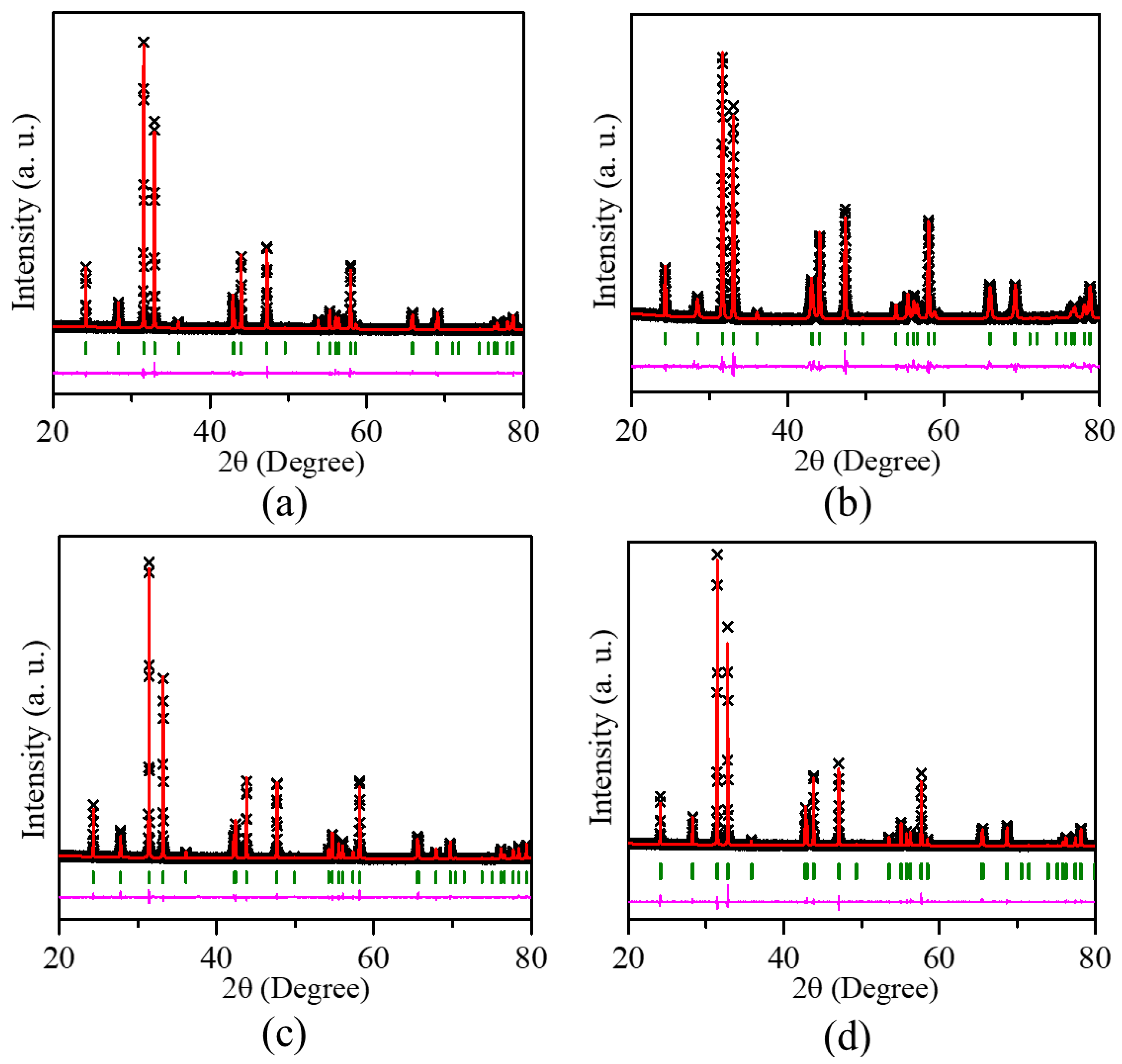
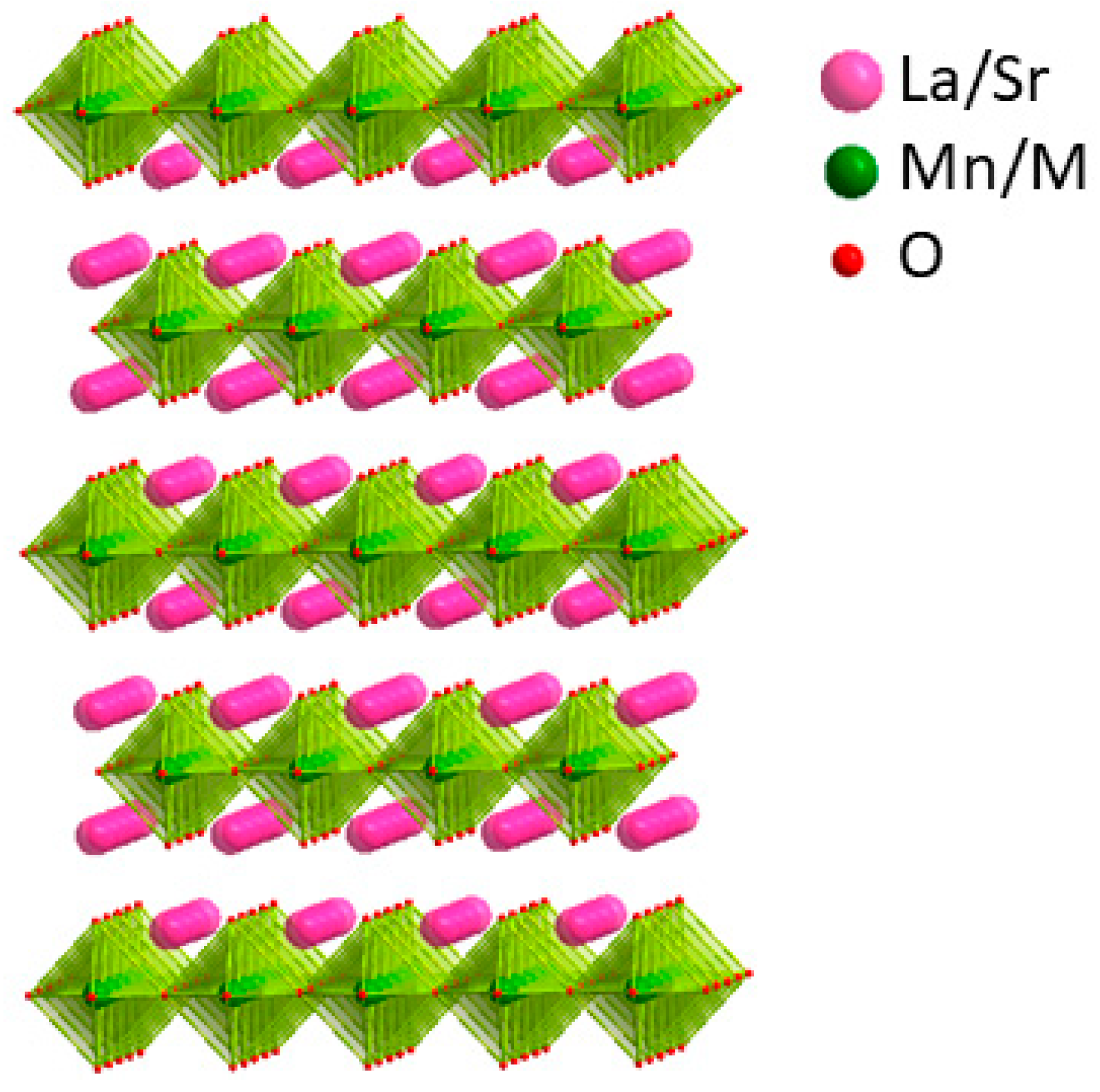
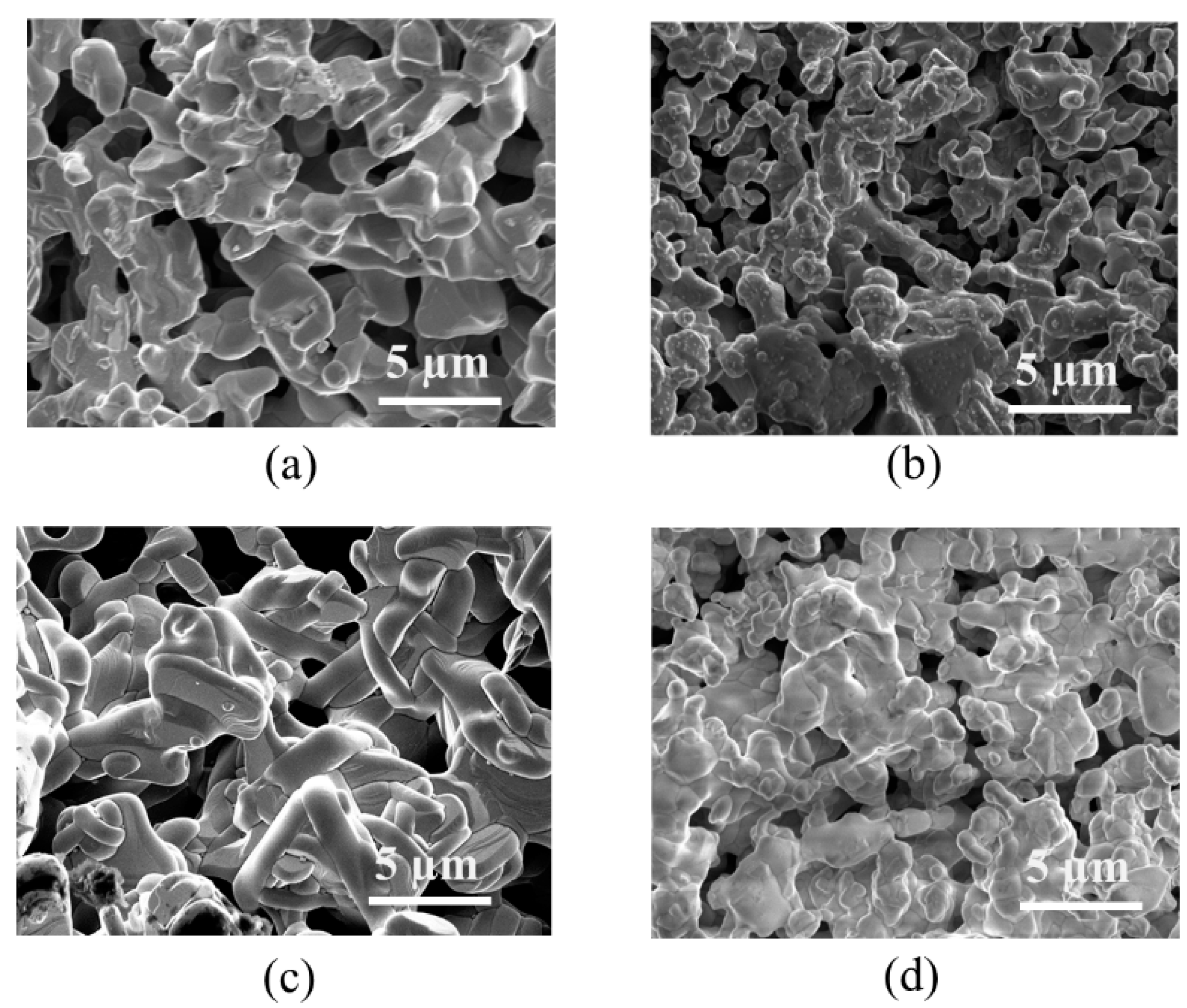
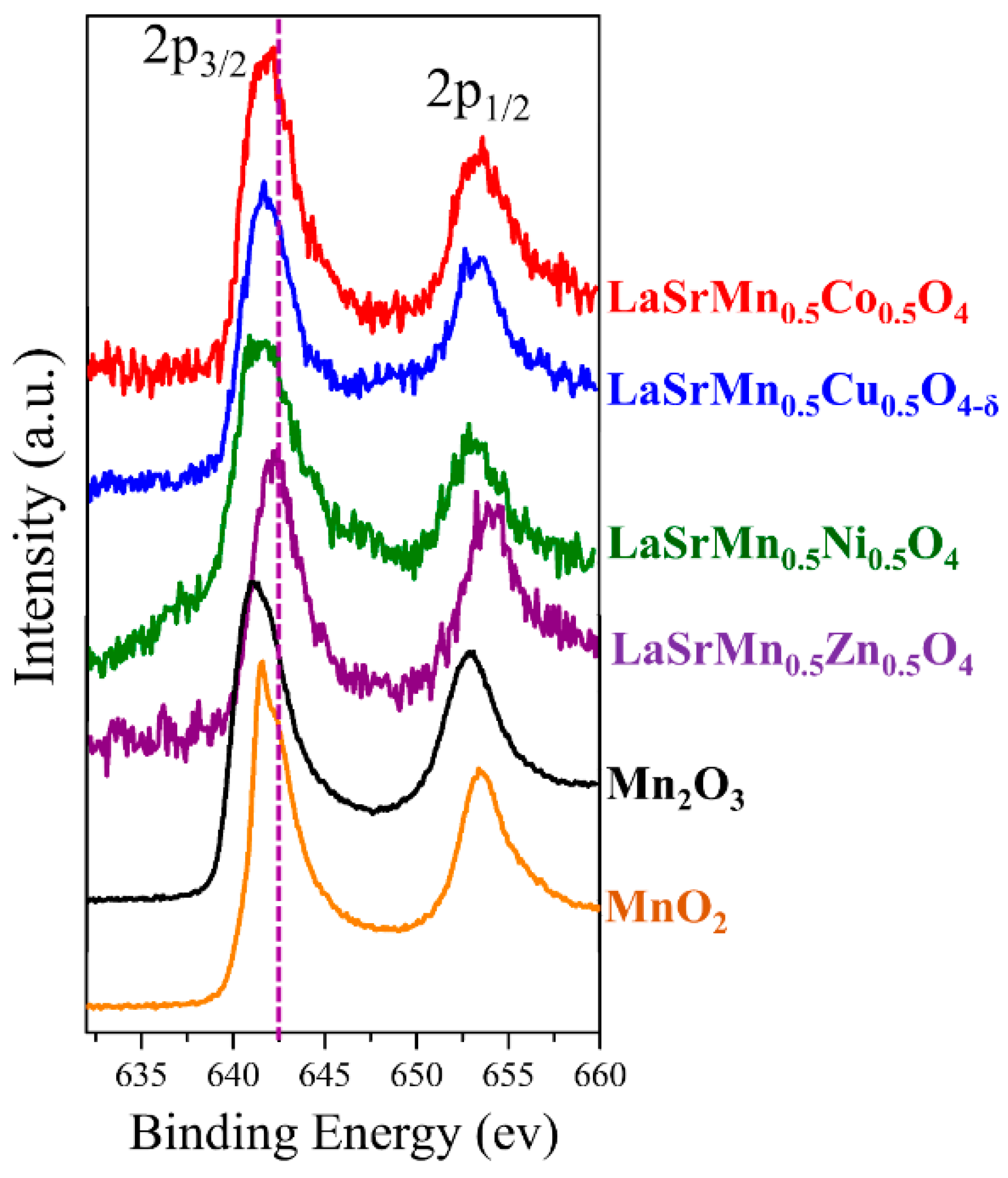

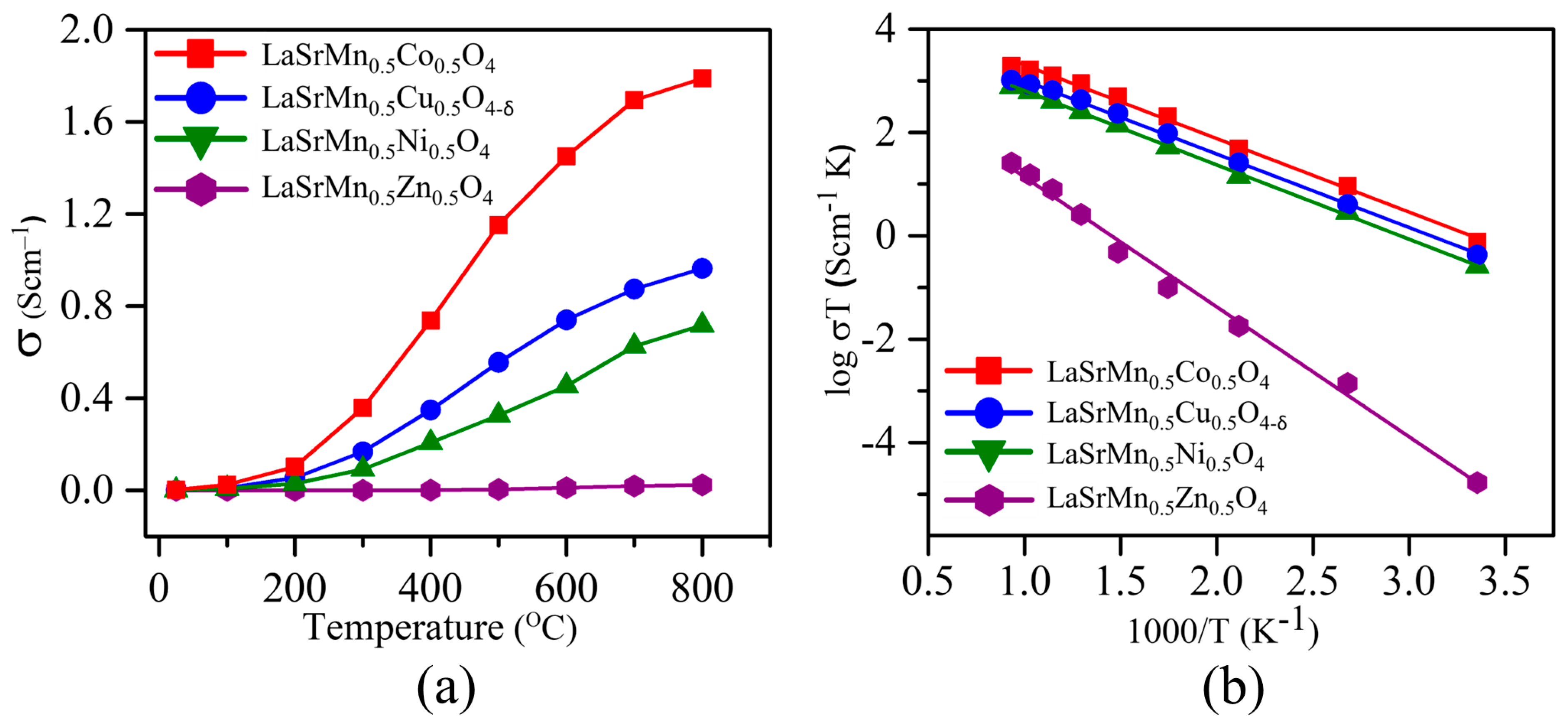
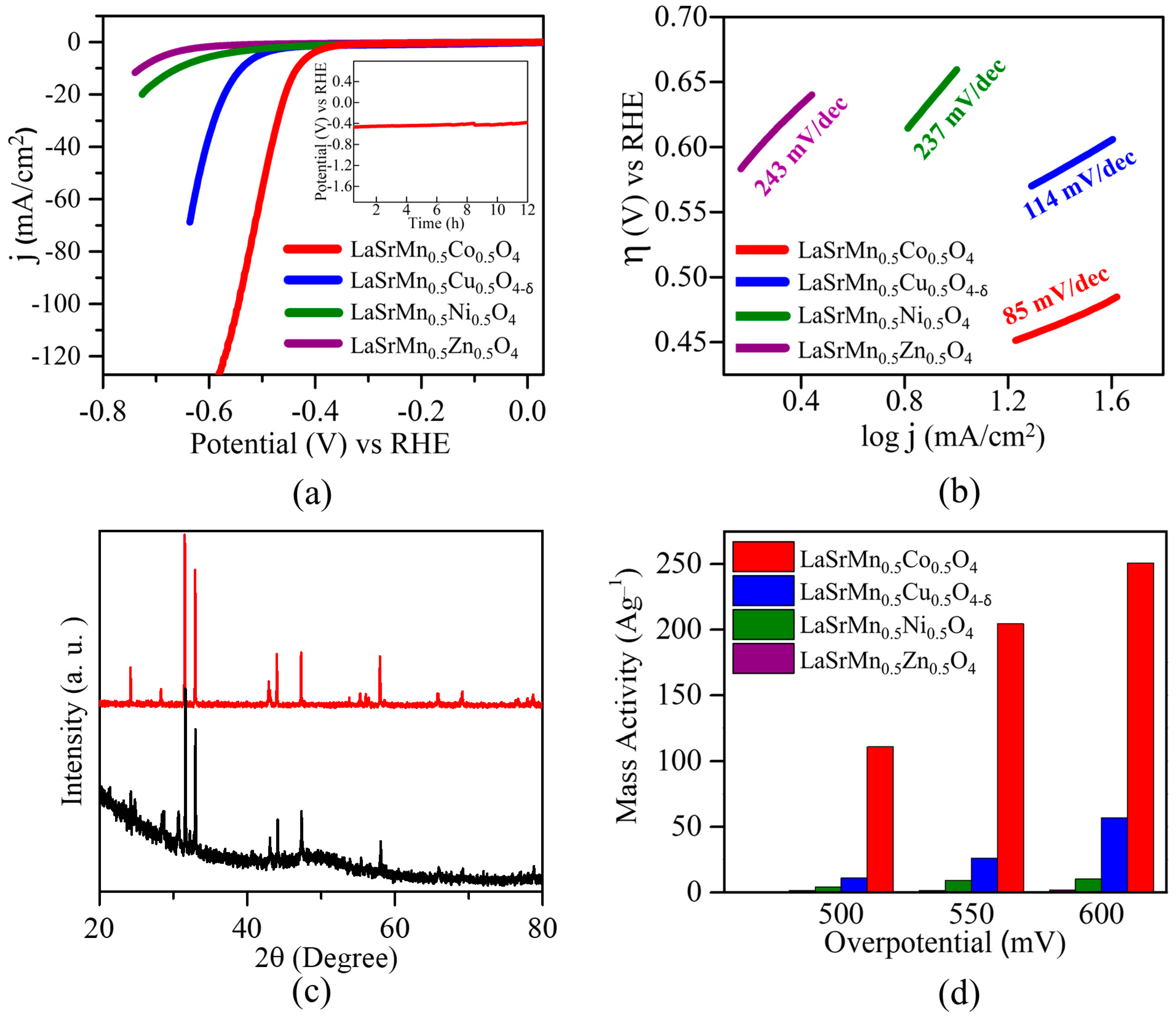
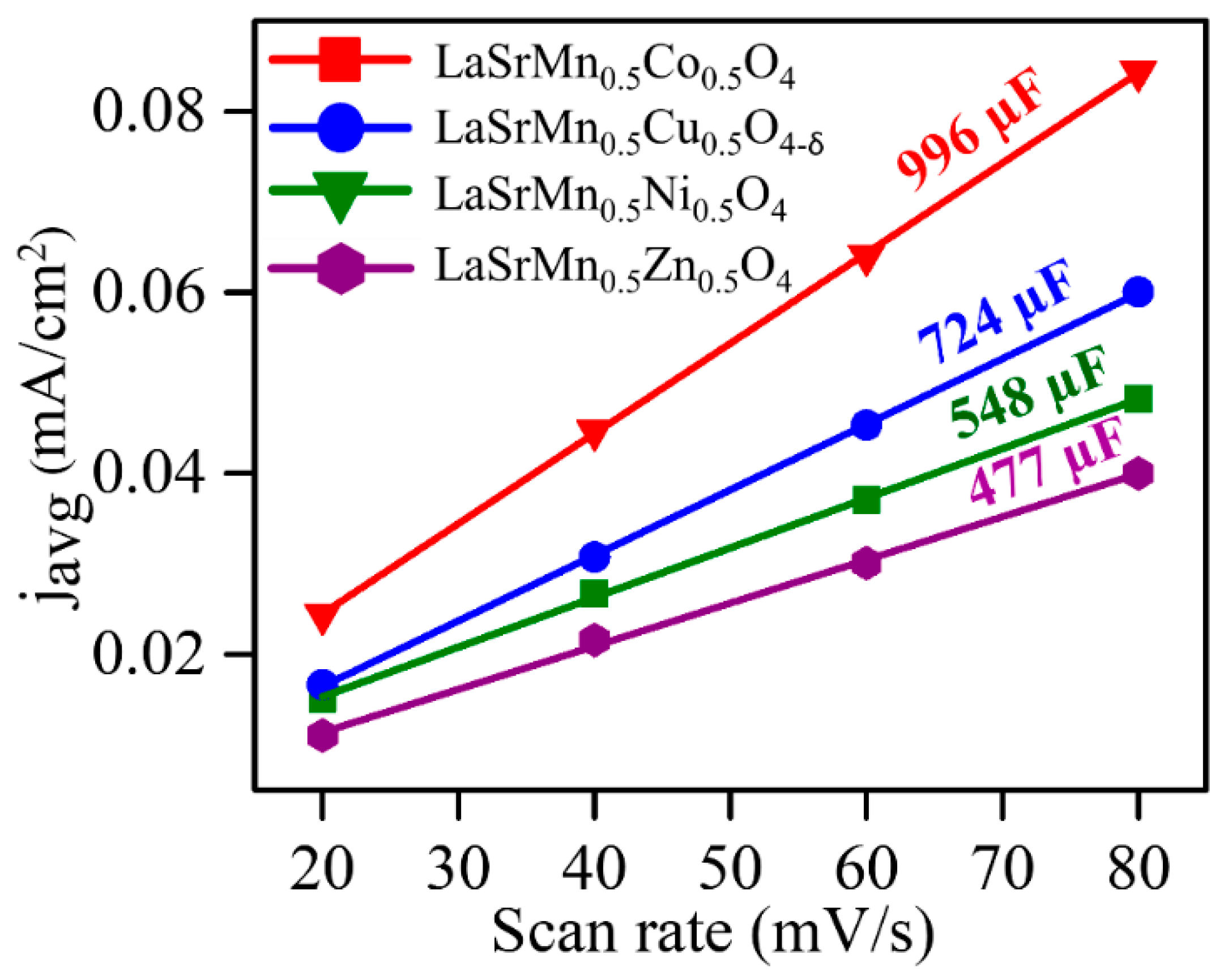
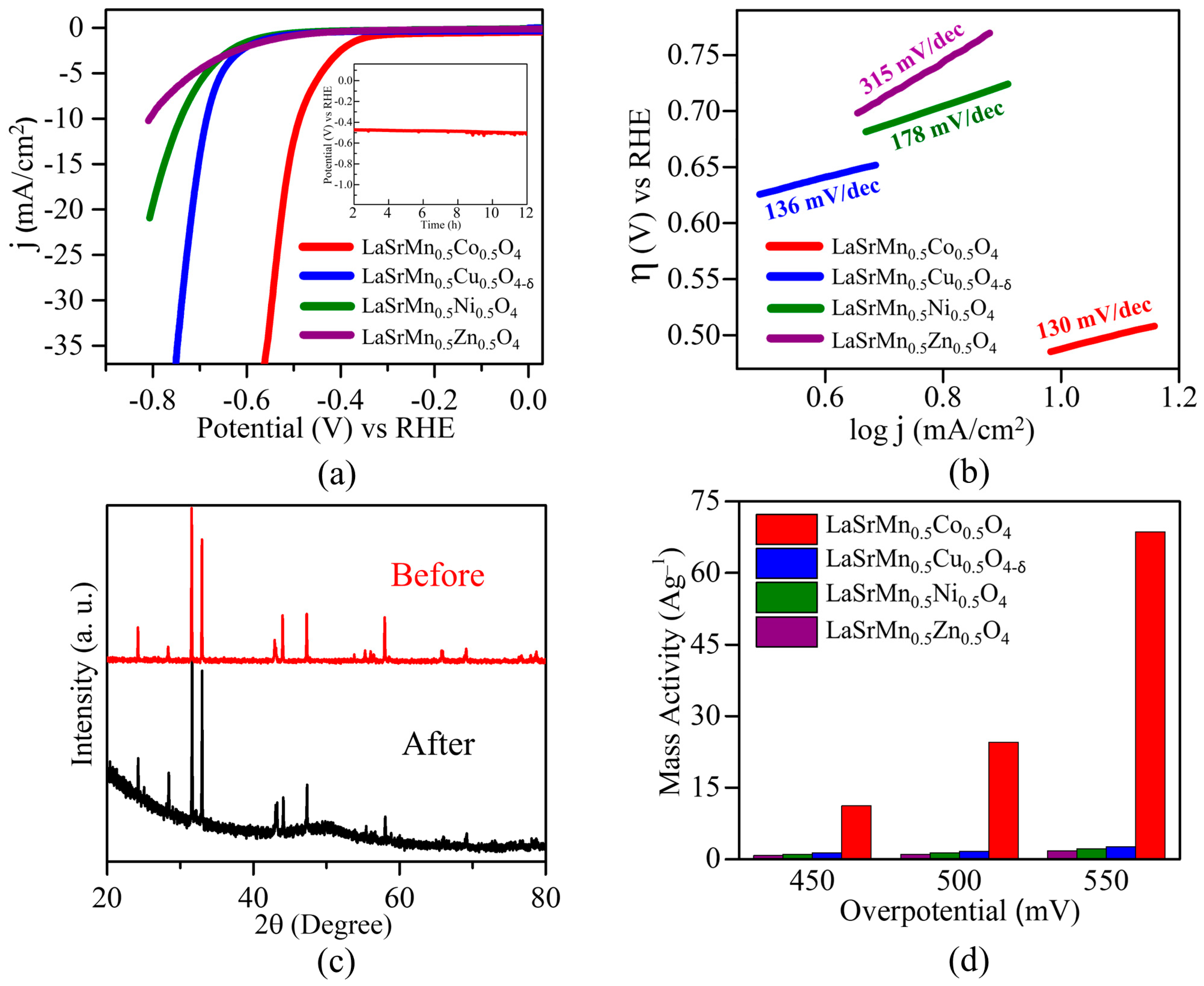
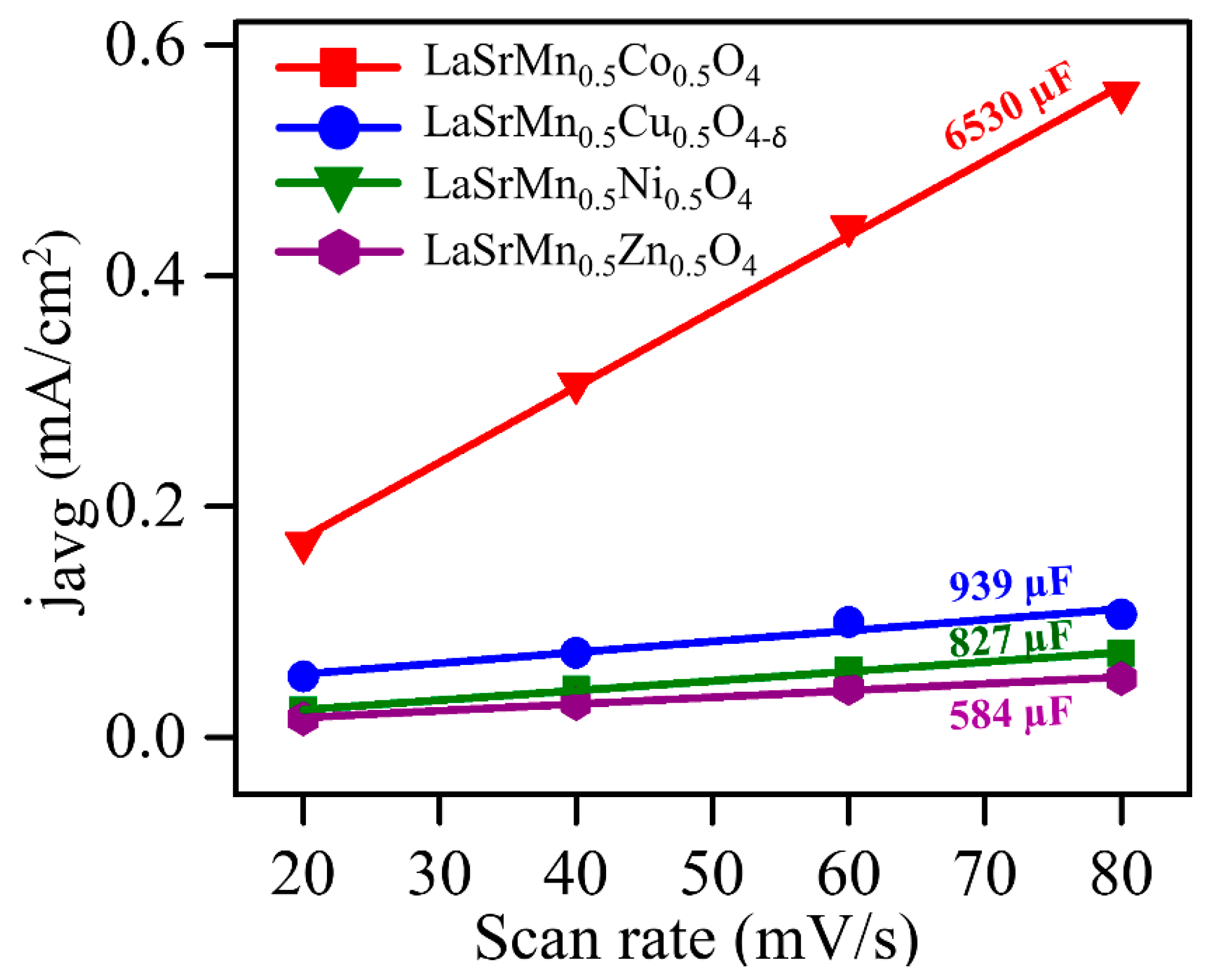

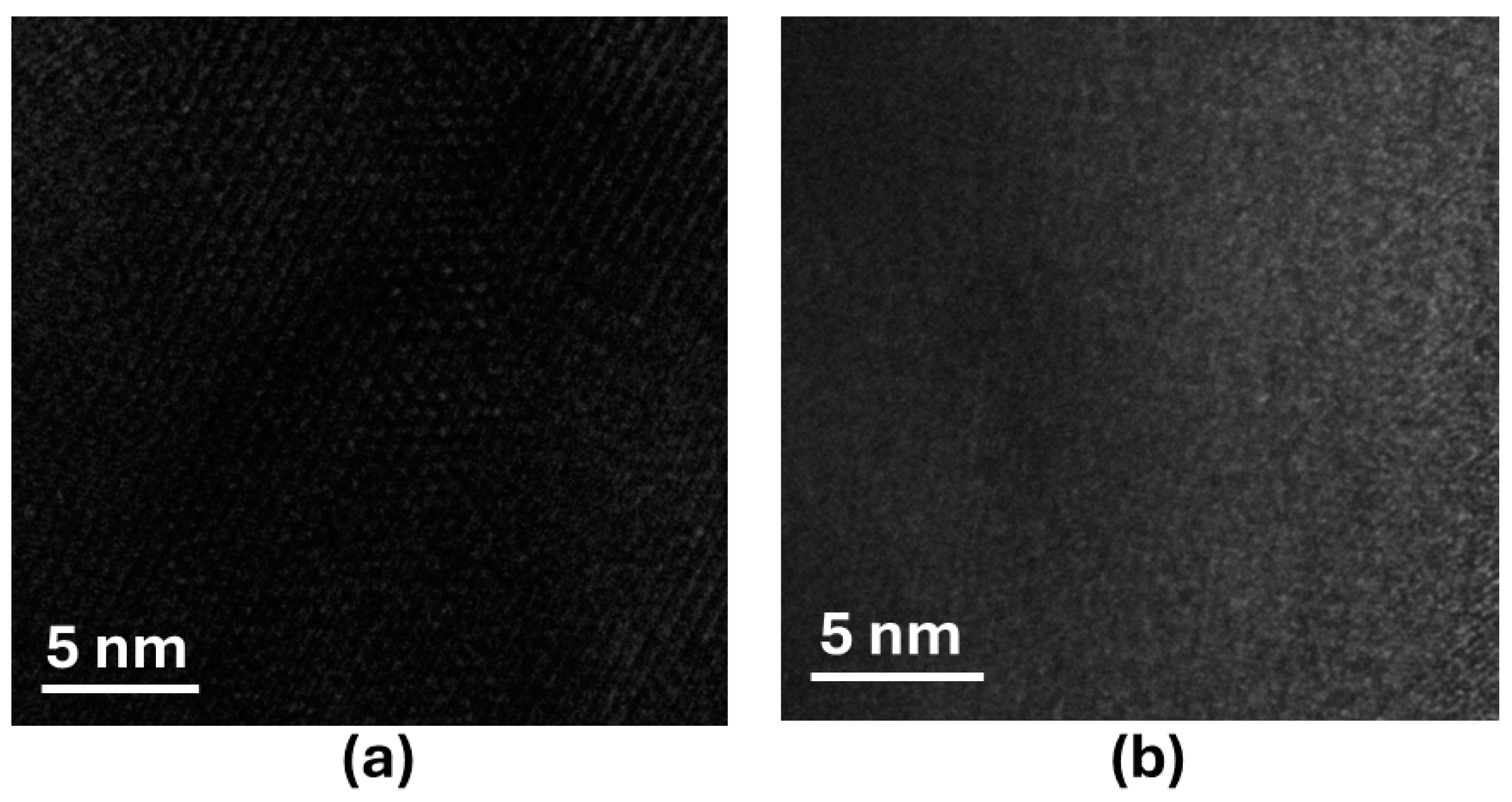
| Atom | x | y | z | Occupancy | Multiplicity | Uiso (Å2) |
|---|---|---|---|---|---|---|
| La | 0 | 0 | 0.35985 (8) | 0.5 | 4 | 0.0192 (5) |
| Sr | 0 | 0 | 0.35985 (8) | 0.5 | 4 | 0.0192 (5) |
| Mn | 0 | 0 | 0 | 0.5 | 2 | 0.0131 (9) |
| Co | 0 | 0 | 0 | 0.5 | 2 | 0.0131 (9) |
| O1 | 0.5 | 0 | 0 | 1 | 4 | 0.031 (2) |
| O2 | 0 | 0 | 0.1642 (6) | 1 | 4 | 0.038 (2) |
| Electrical Conductivity (S/cm) | Activation Energy (eV) | |
|---|---|---|
| LaSrMn0.5Co0.5O4 | 0.0026 | 0.2673 (2) |
| LaSrMn0.5Ni0.5O4 | 0.0014 | 0.2746 (2) |
| LaSrMn0.5Cu0.5O4-δ | 8.5961 × 10−4 | 0.2676 (3) |
| LaSrMn0.5Zn0.5O4 | 7.0755 × 10−4 | 0.4727 (7) |
Disclaimer/Publisher’s Note: The statements, opinions and data contained in all publications are solely those of the individual author(s) and contributor(s) and not of MDPI and/or the editor(s). MDPI and/or the editor(s) disclaim responsibility for any injury to people or property resulting from any ideas, methods, instructions or products referred to in the content. |
© 2024 by the authors. Licensee MDPI, Basel, Switzerland. This article is an open access article distributed under the terms and conditions of the Creative Commons Attribution (CC BY) license (https://creativecommons.org/licenses/by/4.0/).
Share and Cite
Wickramaratne, K.M.K.; Ramezanipour, F. Electrocatalytic Properties of Quasi-2D Oxides LaSrMn0.5M0.5O4 (M = Co, Ni, Cu, and Zn) for Hydrogen and Oxygen Evolution Reactions. Molecules 2024, 29, 3107. https://doi.org/10.3390/molecules29133107
Wickramaratne KMK, Ramezanipour F. Electrocatalytic Properties of Quasi-2D Oxides LaSrMn0.5M0.5O4 (M = Co, Ni, Cu, and Zn) for Hydrogen and Oxygen Evolution Reactions. Molecules. 2024; 29(13):3107. https://doi.org/10.3390/molecules29133107
Chicago/Turabian StyleWickramaratne, Kinithi M. K., and Farshid Ramezanipour. 2024. "Electrocatalytic Properties of Quasi-2D Oxides LaSrMn0.5M0.5O4 (M = Co, Ni, Cu, and Zn) for Hydrogen and Oxygen Evolution Reactions" Molecules 29, no. 13: 3107. https://doi.org/10.3390/molecules29133107
APA StyleWickramaratne, K. M. K., & Ramezanipour, F. (2024). Electrocatalytic Properties of Quasi-2D Oxides LaSrMn0.5M0.5O4 (M = Co, Ni, Cu, and Zn) for Hydrogen and Oxygen Evolution Reactions. Molecules, 29(13), 3107. https://doi.org/10.3390/molecules29133107








